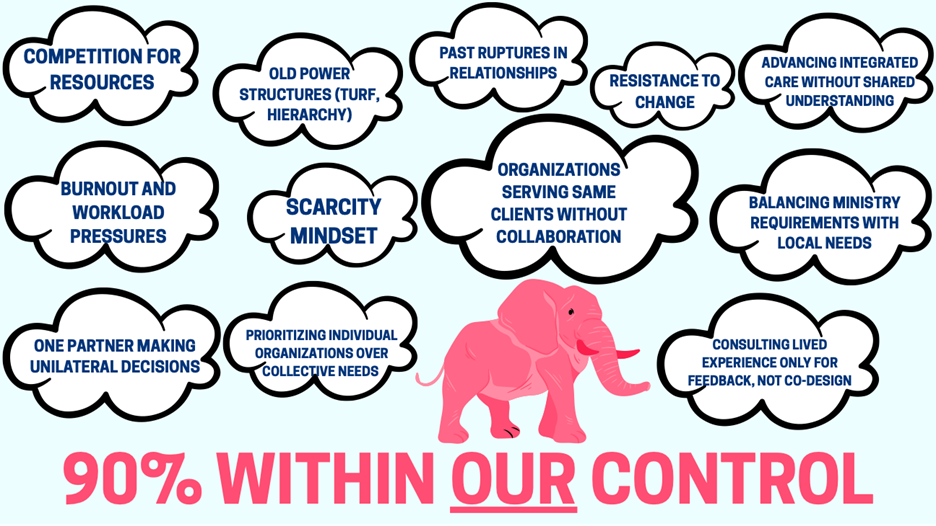We are discovering a shared truth: collaboration is necessary to improve population health outcomes, yet often difficult to reach. The personal desire for working together is strong and absolutely imperative. This is WHY we need to collaborate. What is missing are the enabling conditions that make collaboration possible and sustainable. When we focus on the HOW, we realize our potential for impact.

Trust alone does not clear the path. Every system carries elephants—the unspoken barriers that keep people and organizations from moving forward together. Left unspoken, they create paralysis. Leaders retreat into fight, flight, or shutdown, and collaboration stalls before it begins.
Across hundreds of sessions, we asked participants ranging from formal leaders, clinicians, community members, and people with lived experience to surface the elephants that get in the way of progress. The same themes always surface:
● Competition for resources
● Old power structures (turf vs trust, hierarchy) and lack of distributed leadership
● Individual and team burnout and pressures
● One partner making decisions that impact the collective
● Multiple organizations serving the same clients but not working together
● Scarcity mindset
● Putting individual organizations first when collaboration is required.
● Resistance to change
● Previous ruptures in relationships (between individuals, organizations, sectors)
● Consulting people with lived experience (including patients, families, caregivers)—if at all—for feedback rather than partnering and co-designing together.
● Advancing integrated care initiatives without understanding what integrated care is and learning alongside each other
● How to honour ministry requirements while addressing local needs
Once written down, voiced aloud, and worked through together, these elephants begin to lose their power, and a shared plan is put in place to address them. They move from private frustrations to shared opportunities to advance change in a positive direction.
And when the silence breaks, something remarkable happens. The nervous system of the room shifts. Leaders move from defensiveness to curiosity, from isolation to interdependence. The room leans closer to the green zone of social engagement—the state where connection, calm, and creativity allow collaboration to take root.
To learn more about our work on the nervous system of change, read our previous blog here.
Across thousands of participants we’ve worked with, one truth is consistent: about 90% of the barriers identified are within our collective control to change.
Policy and funding limitations are real. But most obstacles lie in how information moves, how organizations choose to work together, and how leaders create conditions for collaboration. These are areas where choice and commitment can shift the trajectory.
Naming elephants is not about blame. It is about clarity. By voicing the unspoken, leaders see that the barriers are not fixed realities. They are patterns ,practices, and mindsets that can be shifted.

And when those elephants are named together, silence gives way to action. What once seemed immovable becomes part of a collective strategy. The elephants no longer hold the power. People do, working in new power ways that prioritize community, shared leadership, and belonging.
This Insight to Action series is an invitation to learn together about how conditions for collaboration are built, how barriers can be named and addressed, and how commitments turn intent into action. It will also share insights from our work. Insights learned and practiced together.
1. From Insight to Action: Connection Is the Correction — Building the Conditions for Integrated Care
2. The Nervous System of Change — how neuroscience shows us that trust is embodied, not abstract. As Stephen M.R.Covey reminds us, “Change happens at the speed of trust.” And inour work, we see the next layer: trust happens at the speed of thenervous system — across individuals, teams, organizations, and sectors.
3. Elephants that need to be named and addressed to move forward — how unspoken barriers keep systems stuck. Naming them is the first step, but the real work is in identifying which are within our control to change, and then acting on them.
4. Advancing on the Collaboration Spectrum — what our data tells us about the gap between the collaboration leaders whether as a person with lived experience, a clinician, a community worker or those in formal leadershiproles across policy, research, organizational and sector leadership want and the collaboration they experience. It also highlights where individuals see themselves in their own growth, where their teams and organizations are positioned, and where they aspire to be.
5. Individual and Collective Commitments — how personal and collective commitments translate insight into measurable action.
To learn more about our collective pursuit and see the upcoming blogs, explore 4CImpact.org or to get in touch with Jodeme (jodeme@4cimpact.org)or Meghan (info@4CImpact.org).